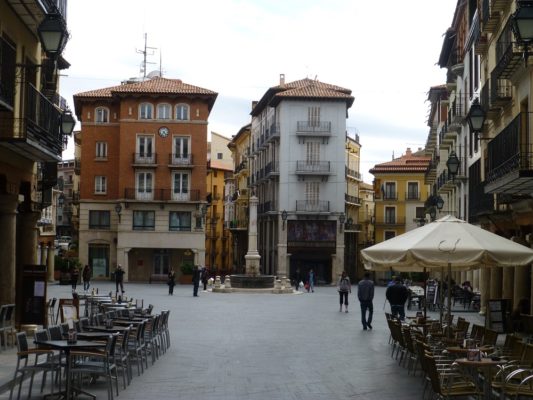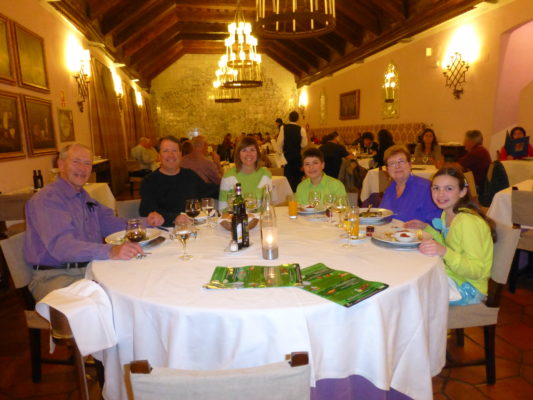April 19, 2013. Day 3. Barcelona to Cuenca.
See Travel Itinerary for a rationale of this trip, and a who’s who of those travelling.
We were up early and eating breakfast at Forns del Pi –again—by 7.30.
We also bought some baguettes for lunch to go with some fantastic Jamón ibérico puro de bellota (ham from pigs that roam oak forests in Extremadura, western Spain) that we had bought the day before at Jamonería Enrique Tomás on Carrer del Pi, just a few steps away from our hotel, Racó del Pi. We planned to picnic somewhere along the road.
Then it was time to call for a taxi to take us to the car rental agency on the Calle de Córcega 293/295, about 15 minutes from our hotels. We had rented a Mercedes Viano van, large enough to carry six, with luggage, comfortably. Both the location and the vehicle turned out to be good choices for us. The agency outlet was very close to the Avinguda Diagonal (Avenue), which led us directly southward out of the city to the main highway to Tarragona. No hassle and no unduly stressful city driving.
It was fortuitous that John, our “designated” driver, had learnt to drive on a gear shift car, because European rental vehicles are not normally available with automatic shift. The van was very comfortable, spacious and with large windows, excellent for sightseeing. John was also pleased that the van had a really tight turning radius, which proved invaluable in the narrow streets and tight corners we encountered in villages and the old quarters of several towns.
With documents signed, everything packed and “Olivia” (our portable GPS from Canada) already calibrated, we were off. Ahead of us a trip of about 550 kilometres to the inland town of Cuenca, where we had booked a night in the Parador Convento de San Pablo (the paradores are a state run chain of hotels).
Our road took us down the Costa daurada/ dorada past towns where tourism has been the major industry since the 1960s, when Northern Europeans flocked southwards thanks to package tours, cheap accommodation and plenty of sun, sand and sangría. The development of former fishing villages into popular resorts brought a lot of much needed money, but in many instances it came at a cost: over development and ugly architecture.
We turned inland just before Tarragona, capital of Roman Hispania Citerior and one of the first major Roman towns in Spain. Its Roman ruins have been have been designated a World Heritage Site by UNESCO.
We next passed Reus, birthplace of Antoni Gaudí (the nearby village of Riudoms also claims to be the architect’s birthplace) and then headed along the A420 towards Alcañiz.
This is a picturesque road, with the landscape changing constantly. Red earth, a patchwork quilt of small fields in fertile valleys below craggy hills, olive and almond groves, rocky terrain interspersed with vineyards, and flocks of sheep.
We arrived at Alcañiz around midday. Overlooking a rolling plain of fertile olive groves and orchards, this historic town is dominated by its castle, which became a parador (Parador La Concordia) in 1968 (http://www.paradores-spain.com/spain/palcaniz.html).
The castle’s chapel and a tower date back to the 12th century when the town was conquered by Christians from Muslims -called Moors in the Spanish context- and handed over to the Order of Calatrava, a religious order of fighting monks, in 1179. However, the parador rooms are located in an 18th-century addition. In all, a lovely place to take a break, enjoy the view, before moving on.
John: We stopped at the Parador of Alcañiz for a washroom break, but I was very happy to look around. It’s an old castle that commands an impressive view of the town and the surrounding farmland. It is easy to imagine the knights of the time surveying the land with a sense of invulnerability.

While the view is nice, I particularly liked the serenity of the courtyard…it was cool and silent when we were there. I also liked the bar, not only because it serves libations, but because it has a really interesting Gothic style ceiling, and vivid paintings on the exit wall which gave me the feeling of hanging out with knights.
Alex: There was a very nice parador up in the hills of Alcañiz. I liked it because it looked old and you could see the town very well.
Shortly after leaving Alcañiz, we stopped for our picnic lunch. The bocadillos (baguettes sandwiches) of jamón ibérico de bellota were so tasty, as food eaten casually outdoors always seems to be. A short walk to digest our food and we were off again.
Soon we passed La Mata de los Olmos with a striking octagonal bell tower atop its Romanesque church.

We had seen similar towers in for example Valdealgorfa, Calanda, Alcorisa, and Alcañiz. Interesting, too, was the number of villages and town we passed with names of Arabic origin; they were very real reminders that the Moors controlled large areas of Spain for up to 800 hundred years (for brief history see al-Andalus). For instance, places beginning with “Al” (Arabic equivalent of the English definite article “the”) or “Cala” (“citadel”) generally indicate former Moorish presence: Alcañiz, Alcorisa, Calanda, Calaceite,

Turning south just after Montalbán, we passed quickly through the former coal mining towns of Utrillas and Escucha. The last mines closed in 2003 and the economy has had to reinvent itself; agriculture here is not much of an option owing to poor, rocky soil conditions.
We were now heading for Teruel about 80 kilometres south. The town was conquered by Christian forces in 1171 during the period broadly known as the Reconquista. It’s a fairly laid back town, and was not overrun by tourists when we were there. It was a beautiful spot to stop and take our breath
Andrew: We couldn’t find a place to park in Teruel so we got stuck driving down the really narrow streets and it was not that much fun to do with a big van.
We went to Teruel because we wanted to see the Mudéjar architecture for which it is famous. There are four tall Mudéjar bell towers -visible for miles around—that rise majestically over the old town. Miraculously they were not destroyed during the Civil war (1936-39) when Teruel was heavily bombarded in one of the most vicious and hard fought battles during the bitter winter of 1937-38 between Republicans and Nationalists.
The 13th-century towers of the cathedral (Santa María de Mediavilla) and the churches of San Martín and San Salvador, in particular (both 14th century), are breathlessly complex, with intricate recessed brick and richly coloured azulejo patterns, blind multilobed, intertwined arches, and window openings split by one, two or even four slender columns (ajímez). Each tower makes distinctive use of these decorative elements, and each adds a mysterious, exotic quality to the town’s landscape. In addition, the cathedral has a stunning artesonado ceiling (i.e. with sunken panels), unusual in that it also contains a series of paintings of hunting scenes and craftsmen at work.

John: The old town seemed like a labyrinth of narrow roads when we arrived and parking was a nightmare until we found the parking at the bus station (also a good place for a washroom break). The walk over to see the famous towers was not long and while I liked the detailed stone and brick work, the plaza we stopped at was my highlight for Teruel. The different coloured houses as well as the old woodwork holding up the fronts make for an attractive and authentic view of “old Spain”. There is also the prerequisite statue and fountain in the centre of the Plaza. There were cafes at one end, but we were too late in the day for the fresh churros Andrew and Alex were looking for.

Alex: We went to Teruel to see their famous towers. They looked very pretty. There was also a cool Plaza, and the streets were very narrow.
If you have a romantic streak in you, you will pay homage to Teruel’s most famous couple, popularly known as Los Amantes de Teruel (the Lovers of Teruel). Teruel was traditionally a honeymoon destination for Spaniards, drawn by the tragic 13th-century tale of two lovers, Isabel de Segura and Diego de Martínez, buried in adjoining tombs in the church of San Pedro.

Another, less well known tragic love tale involves the construction of the towers of San Martín and San Salvador. Two Mudéjar architects, Omar and Abdala, fell in love with the beautiful Zorayda. Shortly after, Omar was given a commission to build the tower of San Martín, and Abdala a similar contract for the tower of San Salvador. Zorayda’s father determined that the one who built the better tower would win her hand. Omar, working night and day, was the first to finish. It was a beautiful tower, but it was leaning to one side. Mortified by his error, Omar climbed to the top of the tower and threw himself off. When Abdala completed his tower it was both beautiful and vertical. As a result he won Zorayda’s hand.
It was late afternoon when we left Teruel, and we had 150 kilometres to Cuenca. We took the N330 south, following the Turia River (on its way to the Mediterranean) for about 35 kilometres.

The countryside was wild and hilly, and remained so after we turned onto the N420 at Torrebaja. Many of the villages looked impoverished and there were signs that some were semi-abandoned (Casas Nuevas) or abandoned entirely (El Cañizar). Those that showed more evidence of well-being tended to be surrounded by flat, fertile land (e.g. Salvacañete).

By the time we approached Cuenca, we were on the easterly edge of the great meseta, a high plateau that covers much of Castile-La Mancha, the autonomous community we were now travelling in. We were up around 3,000 feet, and the land here was very fertile, with fields green with spring plantings of cereals –wheat, and rye, and sunflowers.
The old town of Cuenca (declared a UNESCO World Heritage Site in 1996) is dramatically situated, straddling a steep spur between the Júcar and Huécar rivers.

We arrived fairly late in Cuenca, and headed immediately to the Parador Convento de San Pablo, a 16th-century monastery that is across the gorge from the hanging houses, and has a superb view of them (http://www.paradores-spain.com/spain/pcuenca.html).

Alex: We stayed in the Parador de Cuenca. I really like the paradors that are very old. This one used to be a convent.
The dining room was very elegant with warm terracotta tiles and a superb coffered ceiling. Dinner was pleasant enough, though not memorable; the buffet breakfast was better. On both occasions, however, we were seated at a table for ten, although we were only six. The staff seemed to have difficulty in adjusting to a request for a table for six!
John: We arrived in Cuenca in the early evening and took advantage of their indoor parking (for 15 euros), since parking immediately in front of the parador was very limited and vehicles were somewhat at risk of bumps. The parador is a huge building with large dining facilities.
Dinner over, we were ready for bed. It had been a long day, and our next day promised to be almost as long, Cuenca to Granada: 452 kilometres. And we wanted to see something of the old Cuenca before we left.

Image of Alcañiz: http://en.wikipedia.org/wiki/Alca%C3%B1iz
For those interested, Tarragona and Cuenca are included in UNESCO’s World Heritage Sites while Teruel forms part of UNESCO’s Mudejar Architecture of Aragon:
Tarragon: http://whc.unesco.org/en/list/875
Mudejar Architecture of Aragon, Teruel: http://whc.unesco.org/en/list/378
Cuenca: http://whc.unesco.org/en/list/781
If you want to read an informative article on the future of the paradores, see http://travel.nytimes.com/2013/03/03/travel/spains-paradors-face-an-uncertain-future.html?pagewanted=all
The following are two very interesting blog page about the Lovers of Teruel and the town: the first written by Patrick Walker, who -appropriately- honeymooned there: http://theartichokeadventures.thespanishthymetraveller.com/teruel-love-and-food-in-medieval-times/
The second blog is: http://www.huffingtonpost.com/lori-needleman/spain-teruel-city-of-love_b_1680157.html#s1282880&title=Claustro_de_la
For some excellent photos of Cuenca, see http://www.boomsbeat.com/articles/1849/20140327/35-photos-of-cuenca-spain-an-unusually-well-preserved-medieval-fortified-city.htm






